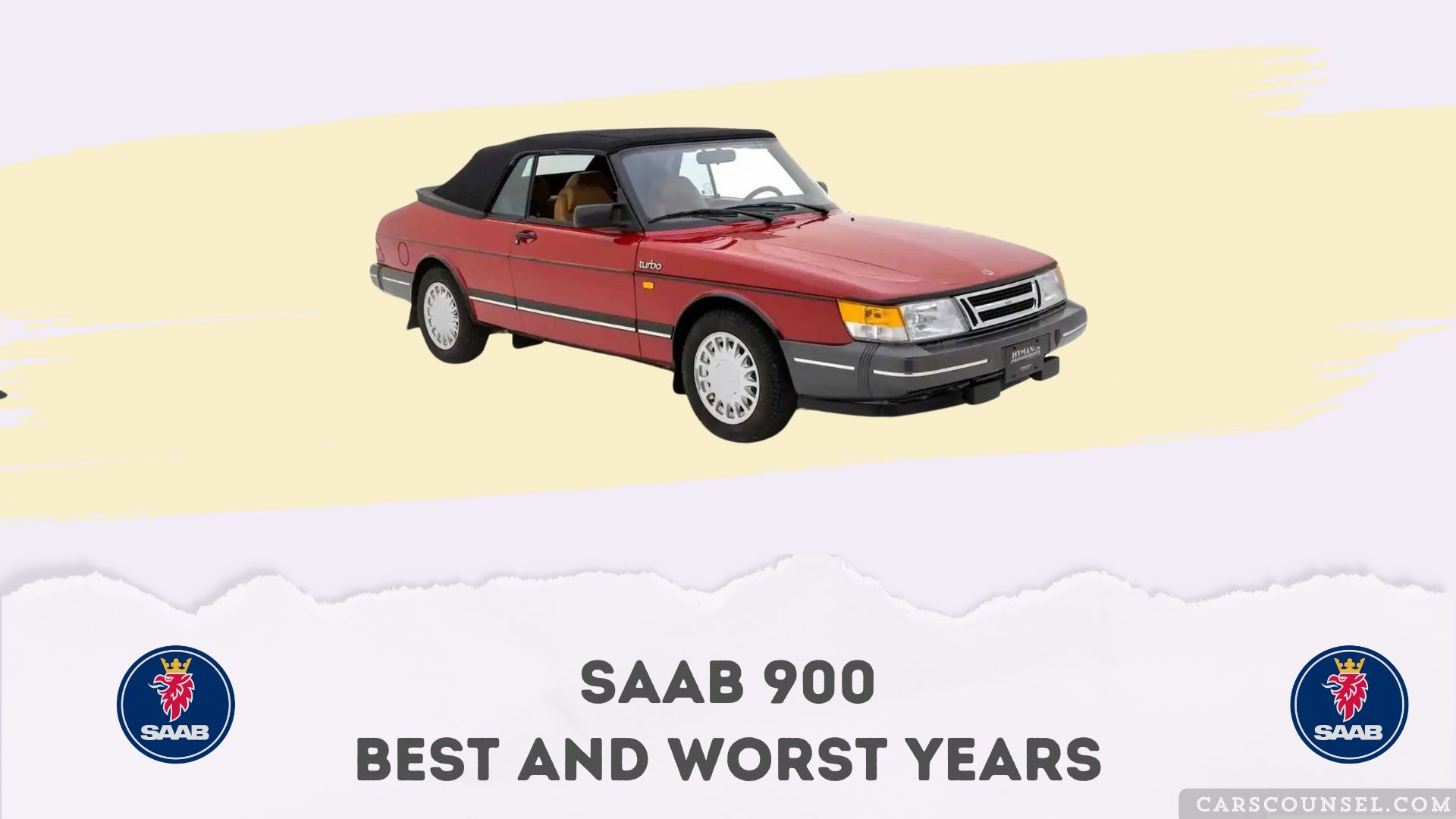In the context of the Saab 900, you’re likely wondering which years to focus on and which to avoid. The truth is, the best years of this iconic model are a bit of a mixed bag.
While the 1990-1993 models offer minor improvements and reliable ECUs, the 1989 models boast better transmissions, and the 1991-1993 models have stronger gearboxes and alloy wheels.
But what about the rest? You’ll want to know more about the troublesome transmission issues and how they impact your buying decision.

Quick Navigation
Key Takeaways
- The best years for the Classic 900 are 1990-1993, with minor improvements and no troublesome ECUs.
- 1989 models are popular for their better transmissions and brakes.
- 1991-1993 models boast stronger gearboxes and better alloy wheels.
- 1998 models are a good choice for the NG900.
- Pre-1989 transmissions have weaker pinion bearings, leading to failure, making them the worst years.
Model Years and Features
When exploring the Saab 900, it’s essential to understand the distinct features and model years.
The Classic 900 (1988-1993) and NG900 (1994-1998) are two different cars.
You’ll find the best model years for the Classic 900 are 1990-1993, with small improvements and no troublesome ECUs.
The 1989 models stand out with better transmissions and brakes, making them popular.
The 1991-1993 models boast stronger gearboxes and better alloy wheels.
Meanwhile, the 1998 models are a good choice for the NG900.
Understanding these model years will help you make an informed purchase decision.
Gearbox and Turbo Issues
As you’ve narrowed down your search to a specific model year, it’s now important to weigh the potential pitfalls.
Gearbox issues are a major concern, especially with turbo models. Automatic gearboxes can be expensive to replace, up to $4,000, and require engine removal.
Pre-1989 transmissions have weaker pinion bearings, leading to failure. If you notice a faint whine noise at 90km/h in 5th gear, it’s a sign of gearbox failure.
Regular maintenance is key to extending the life of your Saab 900’s gearbox and turbo systems.
Reliability and Maintenance
Your Saab 900’s reliability largely depends on its maintenance and condition.
Regular replacements of consumables like tires, brakes are vital to maintain reliability.
You can tackle some repairs yourself, while others, especially those involving complex components like transmissions and turbos, may require professional expertise.
Be aware that 8v engines can have weak headgaskets, although this issue was addressed in 16v engines, which are generally more reliable.
With proper care, late 80s-early 90s Saabs can be reliable daily drivers, but be prepared to fix occasional minor issues that arise.
Pricing and Market
The prices you’ll encounter for a Saab 900 vary greatly depending on the location.
In Western Canada, you can expect to pay between $3,000 and $6,000 CDN.
In San Francisco, prices are higher, with most 900s selling for around $3,000.
In Europe, classic 900s are considered collector’s items, and prices differ.
In Vancouver, British Columbia, prices range from $3,000 to $12,000.
Keep in mind that the market for 11-year-old cars isn’t huge, leading to lower prices overall.
Be prepared to negotiate and research to find the best deal for your budget.
Buying Strategies and Condition
When buying a Saab 900, you should prioritize the car’s condition over its model year, as a well-maintained vehicle can outlast a poorly maintained one.
Your budget will influence your choices, and you should prioritize your needs to get the right Saab 900 that fits your budget.
Model Year Priorities
Model year takes a backseat to condition in the Saab 900’s case.
You should prioritize the car’s overall state over its age. A well-maintained Saab 900 with desirable features like leather, sunroof, and rust-free conditions can increase its value.
Consider cars with a history and owners who’ve taken care of the vehicle. A clean model with a good mechanic can be a good choice, especially if you’re on a budget.
Condition Over Age
You’re not just buying a model year; you’re buying a car’s history.
In terms of the Saab 900, the condition of the car is vital than its age.
What’s key is:
- Well-maintained older models can be a better buy than neglected newer ones.
- Desirable features like leather, sunroof, and rust-free conditions increase the car’s value.
- Caring owners who maintained detailed records are ideal finds.
- Pristine condition with no issues holds higher value than those with mechanical repairs, even with motivated sellers.
Overview
The Saab 900’s production spanned over two distinct model generations, with the Classic 900 (1988-1993) and NG900 (1994-1998) boasting unique characteristics that set them apart.
As a buyer’s guide, you’ll want to focus on the Classic 900, considered the best model year.
Look for 1988 models with a 16-valve engine, water-cooled turbocharger, and rear handbrake.
The 1989 models offer better transmissions and updated brakes, while 1990-1993 models feature gearboxes and better-looking alloy wheels.
If you’re looking for a reliable Saab 900, consider the 1991-1993 models or the 1998 NG900 for a well-rounded experience.
Problem Areas
Rust and wear can creep up on you, particularly in the Saab 900’s vulnerable areas.
Be aware of the following potential problem areas:
- Rust-prone areas: Wheel arches, suspension mounting points, and front lower frame rails can collect dirt and road crud, leading to serious frame damage.
- Worn-out parts: Ignition switch, timing chain, and tensioner are prone to wear, requiring regular maintenance to prevent failures.
- Transmission issues: First and reverse gears may show initial weaknesses, especially with the three-speed transmission, which can greatly sap performance.
- Exhaust system: Rust can occur in as little as 75,000 miles, and replacement can be expensive.
Value
In terms of buying a used Saab 900, its value can vary greatly depending on several factors, including location, model year, and condition. You’ll find prices ranging from $450 to $1,000 for a used Saab. But, location plays a significant role, with Western Canada averaging $3-$6,000 CDN, San Francisco around $3,000, and Europe considering classic 900s as collector’s items.
| Location | Price Range | Notes |
|---|---|---|
| Western Canada | $3,000 – $6,000 CDN | Averages around $4,500 CDN |
| San Francisco | $2,500 – $3,500 | Higher prices due to demand |
| Europe | $5,000 – $10,000 | Collector’s items, prices increasing |
Recent Sales
Recent sales data reveals you’re likely to find a premium for low-mileage models, especially those with a full service history.
As you examine recent sales, you’ll notice certain trends emerging.
- Low-mileage models sell fast: If you’re selling a Saab 900 with low miles, expect it to fly off the market quickly.
- Full service history is key: A full service history can increase the resale value of your Saab 900 significantly.
- Condition trumps age: The condition of your vehicle matters more than its age in regards to recent sales.
- Research is essential: Make sure you investigate recent sales data to get an accurate estimate of your Saab 900’s value.
Design and Features
As you shift your focus from the sales data to the design and features of the Saab 900, you’ll likely be struck by its unmistakable silhouette.
The classic shape is still recognizable, with a curved windshield and sloping hatchback adding to its appeal.
The car’s long nose and sloping hatchback shape made it look sexy, even to jaded journalists.
Available in four body styles, including three- and five-door hatchbacks, a four-door sedan, and a convertible, you could customize your ride with a body kit to give it an extra edge.
Engine and Performance
You’ll find the Saab 900’s engine and performance to be a fascinating aspect of this iconic car.
The turbocharged inline four-cylinder engine featured a 45-degree slant toward the passenger side. Three engine variations were offered, including the eight-valve H-spec and the twin-cam, 16-valve version.
- Turbo engine compression ratios varied throughout the model years, with the 16-valve H engines benefiting from better fuel and boost management.
- The 16-valve H engines had a 8.5:1 compression ratio, dramatically improving off-boost performance and drivability.
- Horsepower increased by five in 1987 and another 10 in 1990, thanks to a new Mitsubishi-sourced turbocharger.
- The 16-valve H engine’s turbo setup provided better performance and drivability, making it a desirable option for Saab enthusiasts.

